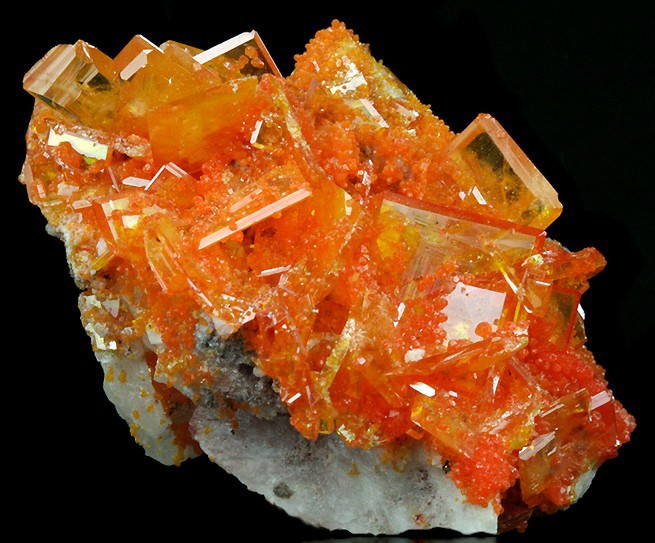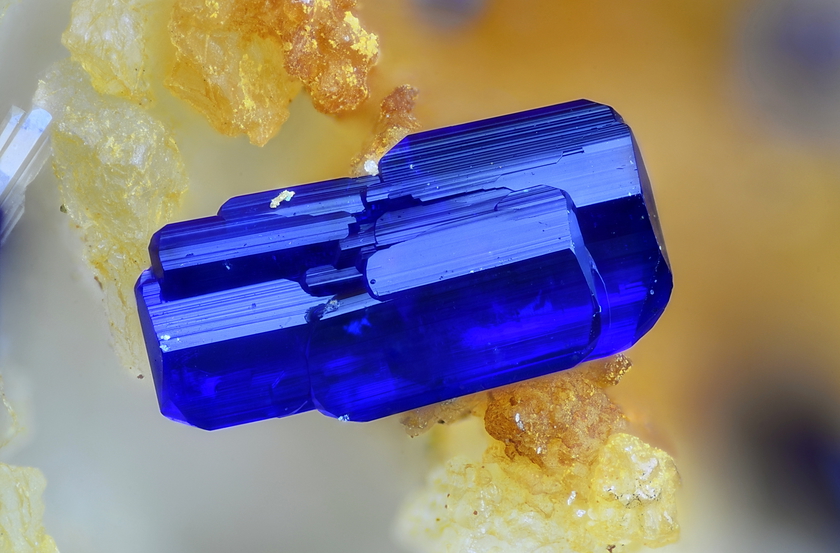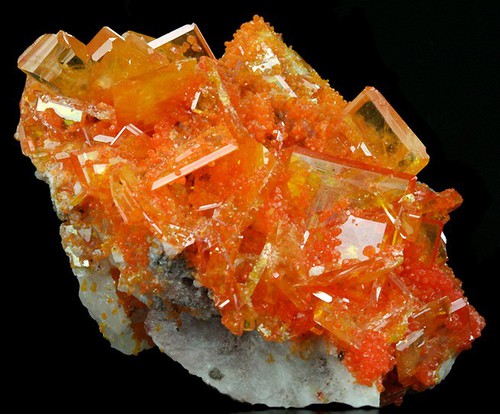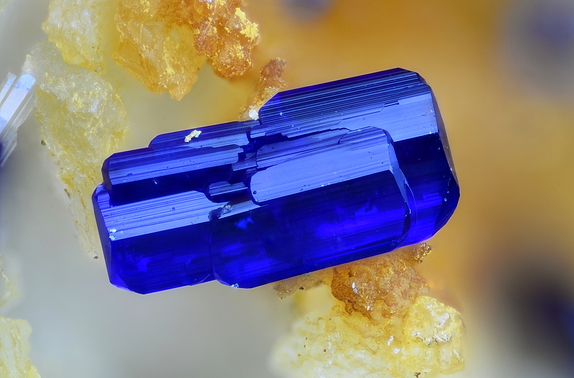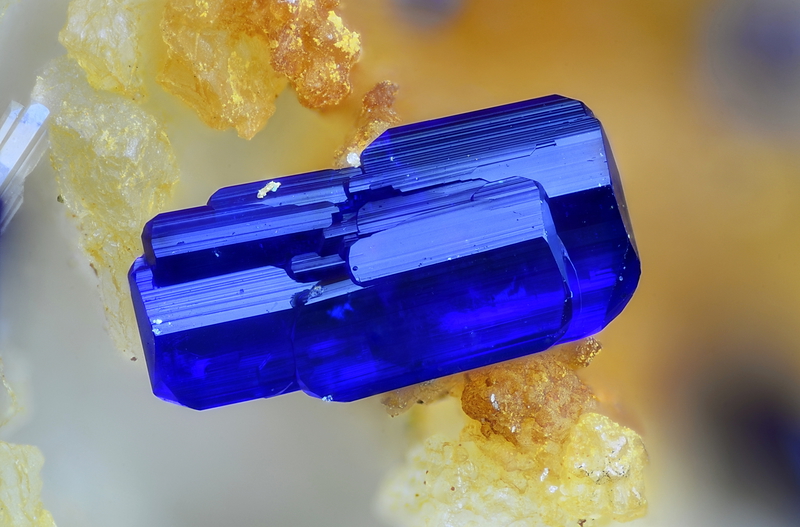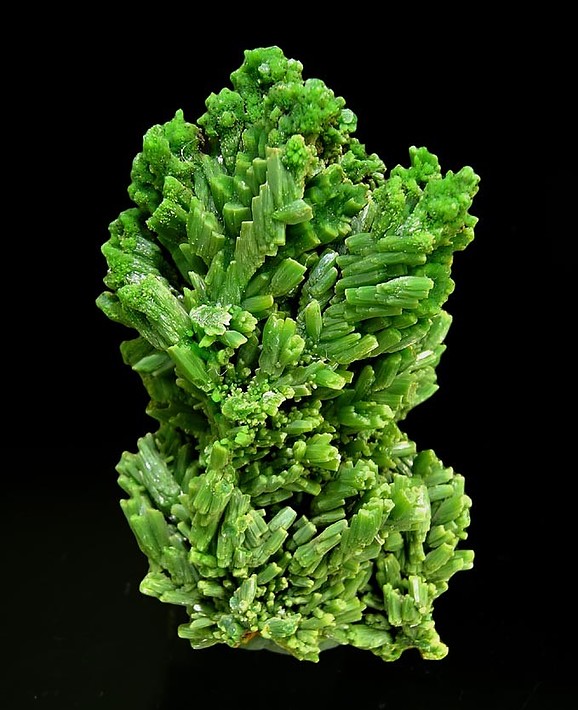
Mineral Evolution
By Jolyon Ralph
Around 2.4 billion years ago something dramatic happened on the young earth causing the greatest climatic change the planet has ever seen. The Great Oxidation Event (or GOE) dramatically and permanently changed the atmosphere of our planet from the primordial methane-rich atmosphere into the oxygen-rich atmosphere that we breathe today.
The driving force behind this change was life - primitive single celled life with the ability to photosynthesize - taking in carbon dioxide and the light from the warm, young sun, and giving our oxygen. Experts believe that these cyanobacteria evolved the ability to photosynthesize as early as 3.5 billion years ago but the oxygen being produced by life before the GOE was being eaten up by iron in the rocks and the oceans - turning it to rust - rather than building up in the atmosphere. The bacteria kept on doing what they do - producing oxygen - until, around 2.4 billion years ago, there was no more unoxidized iron left in the Earth’s crust or surface waters. The result, a runaway buildup of oxygen in the atmosphere, changed our planet forever.
Earth Scientists studying the early history of our planet are now beginning to realise that it wasn’t just the atmosphere that was affected - this event changed the very rocks and minerals that our crust is made out of - and just as life experienced a boom of growth and diversity, so has the mineral world.
There are just over 5,100 unique mineral species currently known, with several dozen new species being reported every year.
Minerals can be divided into several groups, or classes, based on their chemical composition. These primary classes (depending on exactly which classification system you follow) are Elements, Sulfides, Halides, Oxides, Carbonates, Borates, Sulfates, Phosphates, Silicates and Organic compounds. You can explore the different mineral groups within the Strunz system here.
The distribution of minerals is not random - different minerals are found in different environments based on their different method of formation. For example, most borate minerals are found in evaporite deposits where ancient seas have dried up, allowing the dissolved boron content in seawater to crystallise out as borate minerals such as borax, ulexite and colemanite.
These minerals are, however, relatively young. The large borax deposits in California are, for example, mostly less than 10 million years old, an almost insignificantly small fraction of the earth’s 4.6 billion year history. The oldest minerals on earth are zircon crystals, some are dated back to nearly 4.4 billion years. But zircon is a survivor. It is tough - hard enough to resist erosion, it has a high melting point and it is unaffected by almost any chemical attack. Other contemporary minerals to these zircons will have been destroyed and recycled - many times - by now. But the zircon grains can survive.
Some Zircon crystals show multiple rings of successively younger zones of zircon, just like rings in a tree, revealing crystals which have been through the cycle of erosion, subduction and emplacement in new igneous rocks many times. But a lone survivor from our early past doesn’t help us understand the full picture of how the mineral world has changed in the last 4.6 billion years - for that we need minerals that are even older.
The most common type of meteorite is called a chondrite. Although we often think of meteorites as being primarily made of nickel and iron, it is the stony chondrites that make up 80 to 90% of all meteorite falls. Nickel/iron meteorites are usually easier to find as they are heavy, stand out more, and can be more easily located with metal detectors.
Chondrites formed during the accretion of the early solar system, probably as smaller asteroids, before breaking up into fragments that eventually became caught by our gravity and fell to Earth. Unlike larger asteroids or planets, they never became large enough that the internal heat and pressure was enough to melt and recrystallize the material into new rock, so these chondrites contain particles that were part of the original presolar nebula - predating the formation of the solar system. Material in these grains contain differing isotope ratios to those normally found in our solar system, pointing to origins in a variety of different astrophysical processes, showing the material came from a variety of pre-solar system sources. Some of these grains may be very, very old indeed.
What does the mineral makeup of these presolar grains tell us? What mineral diversity did we see at the very start of the solar system? So far, there have been around twelve mineral species - known as 'ur-minerals' - isolated from this presolar dust:
Table 1. Ur-minerals - Minerals found in presolar grains from chondrite meteorites. | ||||||||||||||||||||||||||||||||||||
|
Significantly, all of these minerals fit into just three of our mineral classes, native elements, oxides and silicates. It seems, when our solar system started, that the mineral world was very simple indeed. Certainly, there will be more that are yet to be detected within these presolar grains. They extremely difficult to work with due to their tiny grain size, and so positive identification of the mineral grains is not always possible. In addition, in the billions of years these grains have been in space they've been subject to both solar radiation and bombardment with other objects that can form new minerals. It's hard to be sure which species are original and which aren't, but we're reasonably confident that the minerals listed above were present at the very start.
How did we get from a dozen mineral species to 5,100?
Once the Earth had formed, the melting, mixing and crystallization of this new material generated new mineral species. But how many species did the early earth have before the chemistry of our planet was so drastically altered by life? This is a question that the Mineral Evolution Project.
Robert Hazen, from the Geophysical Laboratory at the Carnegie Institution of Washington and a number of other international scientists, have been working on building a theory of mineral evolution. Just like with the evolution of life, this theory starts with the Earth being formed with a very small number of species and with new species 'evolving' as geological conditions change until reaching the 5,100+ number that we have today.
The following table shows a rough estimate of the number of species that were present at each stage in the evolution of the mineral world. Meteorites give us a great deal of information to help understand the earliest mineralogy of the solar system.
Table 2. Terrestrial Mineral Evolution (after Hazen and Ferry 2010) | |||||||||||||||||||||||||||||||||||||||||||||
| |||||||||||||||||||||||||||||||||||||||||||||
A significant part of this research involves building a new database of mineral ages to track mineral evolution. Since the introduction of the mass spectrometer for mineral age determination in the 1950s there have been hundreds of thousands of analyses done on mineral samples from all over the world as part of countless diverse mineralogical and geological research projects, but this data has never been combined until now. This mineral evolution database, being run out of the University of Arizona in Tucson, is cross referencing this data with the mindat.org database to try to estimate when minerals first appeared, and how it relates to other significant events in Earth history.
To start with, the project has been taking samples of minerals containing less-common elements, for example beryllium. There are 108 known minerals containing beryllium, and already the project has age data for 107 of them (data for the age of the mineral jeffreyite could not be found).
Three billion years ago, there were no recorded beryllium minerals. 2.5 billion years ago, there were around 20. One billion years ago, the cumulative total of beryllium minerals was around 70, and by 250 million years ago, it was nearer to 90. One interesting correlation that appears with the minerals of other elements too is there appear to be 'bursts' of new mineral species first appearing during the breakup periods of the supercontinents.

Graph after Hazen & Grew (2014)
Research into mineral evolution suggests that many of the minerals that contain oxygen and water in their structure have only formed since the Great Oxidation Event - and in the mineral world this contains some of the most beautiful and striking minerals we know, for example secondary minerals such as wulfenite, azurite, and pyromorphite.
There are of course big challenges with this research. As the majority of our crust has been recycled through plate tectonics, and those areas that have remained with relatively older rocks (called cratons, and primarily the interiors of continents), have had their near-surface layers entirely stripped by billions of years of erosion (and the surface layers are where the unusual secondary minerals are found) it’s almost impossible to get a true picture as to what minerals were around in the past, especially those that formed at or near the surface - as with most secondary minerals.
By better understanding the distribution of minerals today (using the mindat.org database) we can make some predictions about what secondary minerals could have been found in the past. For example, almost everywhere on Earth where lead (galena) veins are exposed to the surface you will find cerussite, and often anglesite and/or pyromorphite. These are not rare minerals, and seem to easily form whenever galena is exposed to groundwaters. We can therefore make the reasonable assumption that whenever galena-bearing veins were exposed in the past, and there was free water and oxygen, these minerals could (and probably did) form. We don't need to find a 1 billion year old pyromorphite specimen to know that it probably existed back then.
Can this information help us to determine if other worlds have ever supported life? It seems that a large mineral diversity is something that could indicate a previously active biosphere. The mineral diversity of rocks returned from the moon has shown a more complex mineralogy than those found in meteorites, but far less diverse than the earth, with about 100 species listed. Information from Mars probes about past life on that planet has been tantalisingly inconclusive, but several sulfate minerals have been detected on Mars, most recently the iron sulfate mineral jarosite, which can only form in the presence of water, and the mineralogy must be far more complex than the Moon.
To truly expand our mineral evolution database what we would really need is somewhere we could find pieces of older Earth crust rock, parts of rock sequences that have long been lost from the planet. Unfortunately, there’s nowhere on the Earth these can now be found. But, quite possibly, the Moon may be littered with debris blasted off of earth during past asteroid impacts. Just as lunar and martian meteorites have given us significant detail about the geology of these bodies, perhaps future generations of lunar explorers will be finding long-lost fragments of the Earth’s early crust as meteorites on the moon.
Note: A version of this article was previously published in Astronomy magazine. Reused with permission.
References
Hazen, R. M., Papineau, D., Bleeker, W., Downs, R. T., Ferry, J. M., McCoy, T. J., Sverjensky, D. A., Yang, H. (2008) Mineral evolution. American Mineralogist, 93 (11) 1693-1720 doi:10.2138/am.2008.2955
Hazen, R. M., Ewing, R. C., Sverjensky, D. A. (2009) Evolution of uranium and thorium minerals. American Mineralogist, 94 (10) 1293-1311 doi:10.2138/am.2009.3208
(2010) Mineral Evolution: Mineralogy in the Fourth Dimension. Elements, 6 (1) 9-12 doi:10.2113/gselements.6.1.9
(2010) Themes and Variations in Complex Systems. Elements, 6 (1) 43-46 doi:10.2113/gselements.6.1.43
Hazen, Robert M. (2010) Evolution of Minerals. Scientific American, 302 (3) 58-65 doi:10.1038/scientificamerican0310-58
Grew, Edward S., Bada, Jeffrey L., Hazen, Robert M. (2011) Borate Minerals and Origin of the RNA World. Origins of Life and Evolution of Biospheres, 41 (4) 307-316 doi:10.1007/s11084-010-9233-y
Hazen, R. M., Bekker, A., Bish, D. L., Bleeker, W., Downs, R. T., Farquhar, J., Ferry, J. M., Grew, E. S., Knoll, A. H., Papineau, D., Ralph, J. P., Sverjensky, D. A., Valley, J. W. (2011) Needs and opportunities in mineral evolution research. American Mineralogist, 96 (7) 953-963 doi:10.2138/am.2011.3725
Hazen, R. M., Golden, J., Downs, R. T., Hystad, G., Grew, E. S., Azzolini, D., Sverjensky, D. A. (2012) Mercury (Hg) mineral evolution: A mineralogical record of supercontinent assembly, changing ocean geochemistry, and the emerging terrestrial biosphere. American Mineralogist, 97 (7) 1013-1042 doi:10.2138/am.2012.3922
Grew, E. S., Hazen, R. M. (2014) Beryllium mineral evolution. American Mineralogist, 99 (5) 999-1021 doi:10.2138/am.2014.4675
Hazen, R. M., Liu, X. M., Downs, R. T., Golden, J., Pires, A. J., Grew, E. S., Hystad, Grethe, Estrada, Charlene, Sverjensky, D. A. (2014) Mineral evolution: Episodic metallogenesis, the supercontinent cycle, and the co-evolving geosphere and biosphere. Economic Geology Special Publication 18, Society of Economic Geologists. 1-15
Hystad, Grethe, Downs, Robert T., Grew, Edward S., Hazen, Robert M. (2015) Statistical analysis of mineral diversity and distribution: Earth's mineralogy is unique. Earth and Planetary Science Letters, 426. 154-157 doi:10.1016/j.epsl.2015.06.028
Hazen, Robert M., Hystad, Grethe, Downs, Robert T., Golden, Joshua J., Pires, Alex J., Grew, Edward S. (2015) Earth’s “missing” minerals. American Mineralogist, 100 (10) 2344-2347 doi:10.2138/am-2015-5417
Grew, Edward S., Krivovichev, Sergey V., Hazen, Robert M., Hystad, Grethe (2016) Evolution of Structural Complexity In Boron Minerals. The Canadian Mineralogist, 54 (1) 125-143 doi:10.3749/canmin.1500072
Liu, Chao, Knoll, Andrew H., Hazen, Robert M. (2017) Geochemical and mineralogical evidence that Rodinian assembly was unique. Nature Communications, 8. doi:10.1038/s41467-017-02095-x

